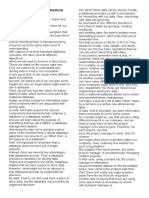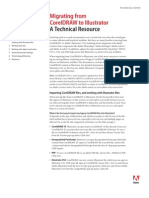JavaScript Is The World
Uploaded by
Reena MadelJavaScript Is The World
Uploaded by
Reena MadelJavaScript is the world's most popular programming language.
It is the language for HTML and the web, for servers, PCs, laptops, tablets, smart phones, and more.
JavaScript is a Scripting Language
A scripting language is a lightweight programming language. JavaScript is programming code that can be inserted into HTML pages. JavaScript inserted into HTML pages, can be executed by all modern web browsers. JavaScript is easy to learn.
JavaScript: Writing Into HTML Output
<html> <body> <p> JavaScript can write directly into the HTML output stream: </p>
<script> document.write("<h1>This is a heading</h1>"); document.write("<p>This is a paragraph.</p>"); </script>
<p> You can only use <strong>document.write</strong> in the HTML output. If you use it after the document has loaded (e.g. in a function), the whole document will be overwritten. </p> </body> </html> You can only use document.write in the HTML output. If you use it after the document has loaded, the whole document will be overwritten.
JavaScript: Reacting to Events
<html> <body> <h1>My First JavaScript</h1> <p> JavaScript can react to events. Like the click of a button: </p> <button type="button" onclick="alert('Welcome!')">Click Me!</button> </body> </html> Output:
My First JavaScript
JavaScript can react to events. Like the click of a button:
Click Me!
The alert() function is not much used in JavaScript, but it is often quite handy for trying out code. The onclick event is only one of the many HTML events you will learn about in this tutorial.
JavaScript: Changing HTML Content
Using JavaScript to manipulate the content of HTML elements is a very powerful functionality
<html> <body> <h1>My First JavaScript</h1>
<p id="demo"> JavaScript can change the content of an HTML element. </p>
<script> function myFunction() { x=document.getElementById("demo"); // Find the element x.innerHTML="Hello JavaScript!"; } </script> // Change the content
<button type="button" onclick="myFunction()">Click Me!</button>
</body> </html>
Output:::
My First JavaScript
Hello JavaScript!
Click Me!
You will often see document.getElementByID("some id"). This is defined in the HTML DOM. The DOM (Document Object Model) is the official W3C standard for accessing HTML elements.
You might also like
- Java Glossary: Compiled by A Passionate Java ProgrammerNo ratings yetJava Glossary: Compiled by A Passionate Java Programmer46 pages
- 6 Google Tricks That Will Turn You Into An Internet DetectiveNo ratings yet6 Google Tricks That Will Turn You Into An Internet Detective5 pages
- Installing and Using Tesseract 500 OCRFINALNo ratings yetInstalling and Using Tesseract 500 OCRFINAL4 pages
- 20341b Core Solutions of MS Exchange Server 2013 v3No ratings yet20341b Core Solutions of MS Exchange Server 2013 v3479 pages
- Xcode 3.1.1 Developer Tools For Mac OS X v10.5No ratings yetXcode 3.1.1 Developer Tools For Mac OS X v10.56 pages
- How To Install All Spectrasonics Stylus RMX (TUT) - AudioSEX - Professional Audio ForumNo ratings yetHow To Install All Spectrasonics Stylus RMX (TUT) - AudioSEX - Professional Audio Forum4 pages
- Deconstruction Magazine Layout Guide Spring 2011No ratings yetDeconstruction Magazine Layout Guide Spring 201113 pages
- Ethical Hacking Guide For Beginners PDFNo ratings yetEthical Hacking Guide For Beginners PDF12 pages
- Apple Remote Desktop Administrators GuideNo ratings yetApple Remote Desktop Administrators Guide191 pages
- The Book of Inkscape, 2nd Edition: The Definitive Guide to the Graphics EditorFrom EverandThe Book of Inkscape, 2nd Edition: The Definitive Guide to the Graphics Editor5/5 (3)
- Work With Strings With Stringr::: Cheat SheetNo ratings yetWork With Strings With Stringr::: Cheat Sheet2 pages
- Apple Javascript Coding Guidelines: Tools & Languages: Other LanguagesNo ratings yetApple Javascript Coding Guidelines: Tools & Languages: Other Languages26 pages
- The 5 Best FREE PDF Apps For iOS and Android 2019No ratings yetThe 5 Best FREE PDF Apps For iOS and Android 201911 pages
- Learning Web Development With Bootstrap and AngularJS - Sample ChapterNo ratings yetLearning Web Development With Bootstrap and AngularJS - Sample Chapter17 pages
- Ipad & Iphone User: Beginner's Guide To The Ipad Everything You Need To Know To Get Started February 2018 PDFNo ratings yetIpad & Iphone User: Beginner's Guide To The Ipad Everything You Need To Know To Get Started February 2018 PDF102 pages
- HTML Crash Course: by Daniel D'Agostino 2 June 2007 Revised 19 June 2007No ratings yetHTML Crash Course: by Daniel D'Agostino 2 June 2007 Revised 19 June 200751 pages
- Visual Studio Code - Mac, Linux, WindowsNo ratings yetVisual Studio Code - Mac, Linux, Windows2 pages
- Android Studio Hedgehog Essentials - Java Edition: Developing Android Apps Using Android Studio 2023.1.1 and JavaFrom EverandAndroid Studio Hedgehog Essentials - Java Edition: Developing Android Apps Using Android Studio 2023.1.1 and JavaNo ratings yet



























































